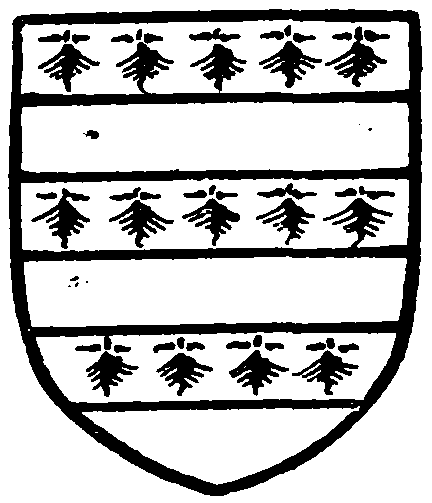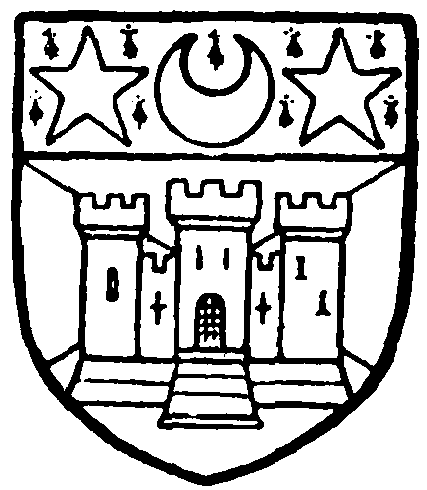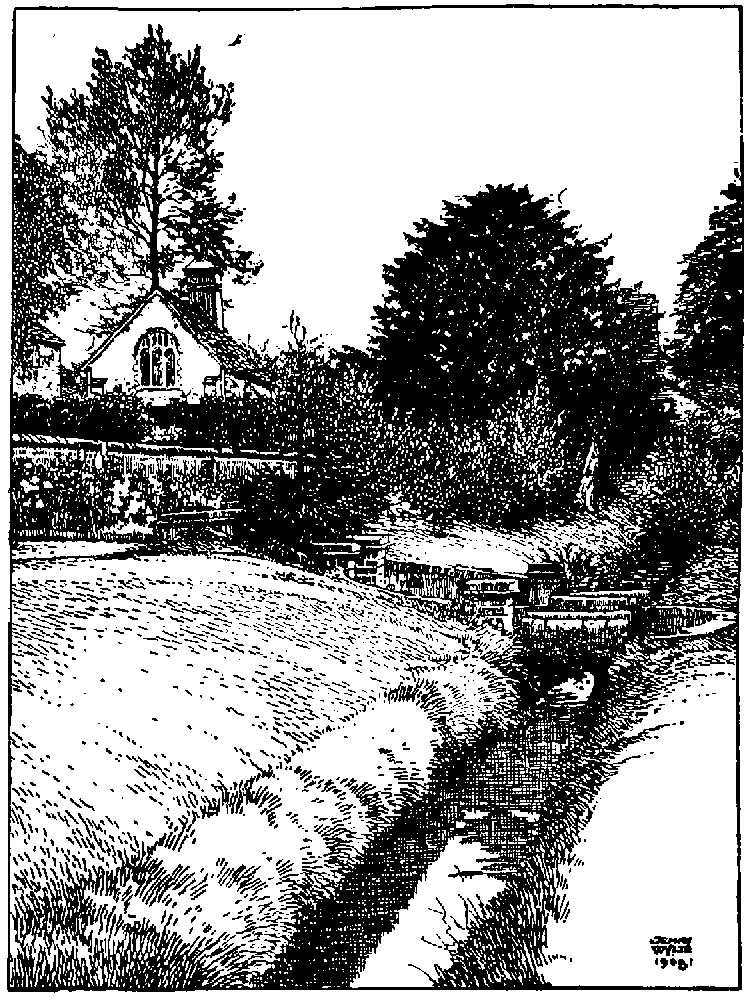Pages 282-285
A History of the County of Hampshire: Volume 4. Originally published by Victoria County History, London, 1911.
This free content was digitised by double rekeying. All rights reserved.
In this section
FREEFOLK
Frigefolc (xi cent.); Frifhoc (xii cent.); Fryfolk (xiii cent.); Freefolke, Frefolk, Fryfolk Syfrewast, Freefolk Sifrewast (xiv cent.); South Fryfolk, South Freefolk (xv cent.).
Freefolk, which is attached to Laverstoke for ecclesiastical purposes, is on the River Test, 1½ miles east of Whitchurch. It is an undulating parish of 1,594 acres, of which 886 acres are arable land and 291 ½ acres permanent grass. (fn. 1) The soil is heavy, the subsoil chalk. The hamlet, which consists of a few houses in the extreme north of the parish, is within the boundaries of Laverstoke Park. Close to the River Test, west of the hamlet, are the old parish church and parsonage, with the Manor Farm near by. The old manor house was pulled down by the late Mr. Melville Portal.
There is one mill on the river, Bere Mill, which is probably built on the site of the mill mentioned in the Domesday Survey as worth 20s. (fn. 2) Henri de Portal settled here after his naturalization at Winchester in 1711, (fn. 3) and carried on the art of paper making, assisted by French workmen. (fn. 4)
The southern part of the parish is open down country with no habitation save a couple of farms and a few cottages. Here and there is a clump of trees, while near New Barn Farm is Brickkiln Wood, and further south Freefolk Wood, forming the southern boundary of the parish.
Manors
FREEFOLK is described in the Domesday Survey of 1086 as a manor held by Ralf the son of Seifrid of the manor of Whitchurch, and as being assigned to the support of the monks of Winchester. (fn. 5) In the reign of Edward the Confessor the tenant was Ednod, 'who held it of the bishop, and could not betake himself anywhere'; a mill is mentioned as worth 20s., and it was stated that the value of the manor had decreased from £16 in Edward the Confessor's time to £10 at the time of the Survey. (fn. 6) The last mention of the bishop as overlord is in 1542. (fn. 7)
Robert de Sifrewast probably held the manor early in the 12th century, as William son of Robert de Sifrewast is described in the return of the Bishop of Winchester in 1166 as holding two knights' fees, (fn. 8) which his father had held before him, (fn. 9) and there is an entry for the following year of half a mark which was paid into the Treasury for 'Frifhoc' by a certain William. (fn. 10) William de Sifrewast, possibly son of the first William, died seised of Freefolk, which Roger de Sifrewast was hol in of him at the time of his death, probably about 1244. (fn. 11) Philippa, William's widow, possibly held in dower after her husband's death, as she had a dispute about her wood in Freefolk in 1253–4. (fn. 12) In 1269 Henry Husee or Hussey acquired the manor from Nicholas Sifrewast, son of William, and he was granted free warren in his demesne lands in Freefolk in 1271. (fn. 13) He died in 1290, leaving as his heir his son Henry. (fn. 14) The latter agreed to allow his mother Agnes to hold in dower one-third of the manor of Freefolk which Anne widow of Nicholas Sifrewast had formerly held. (fn. 15) Henry died in 1331, leaving a son and heir Henry, (fn. 16) but as the manor had been settled upon Henry and his wife Isabel for life it was restored to the latter by the king's command in 1332 (fn. 17); he also assigned to her one-third of an annual rent of £9 10s. issuing out of the manor which had formerly been received by Agnes widow of Peter de Braose, whose first husband was Henry Husee. (fn. 18)

Sifrewast. Azure two gimel bars and a chief or.
In 1346 Henry Husee was holding half a fee in Freefolk which his father had held before him, (fn. 19) and a year later he obtained a final quitclaim of the manor from Joan formerly wife of Walter de Huntingfield. (fn. 20) Henry died in 1349, and the manor then passed in accordance with a settlement of 1347 to his widow Katharine for life. (fn. 21) She subsequently married Sir Andrew Peverel, (fn. 22) and in 1366 joined with her husband and her stepson, Sir Henry Husee, in granting the reversion of the manor after her death to Sir Thomas Ludlow. (fn. 23) Sir Thomas was succeeded by his son and namesake, who granted the manor of Freefolk in 1403 to Mark le Fayre, a citizen of Winchester. (fn. 24) From the latter Freefolk passed by sale in 1411 to Henry Somer and Katherine his wife, who obtained two quitclaims in 1411 and 1419, one from Mark le Fayre, the other from Mark son of Sir Henry (fn. 25) Henry Somer was returned as owner in 1428, (fn. 26) but in 1441 he conveyed the manor to John Roger 'the younger,' of Beenham Valence (co. Berks.). (fn. 27) There were several transfers among various trustees in the following years, and John Roger the elder acquired an interest by entail from Robert Shotesbroke and others, trustees, which interest he gave up to his son in 1460. (fn. 28)

Husee. Barry ermine and gules.
John Roger the younger died in 1486, leaving as his heirs his daughters Anne, wife of John Brocas, and Elizabeth, who subsequently married Richard Andrews. (fn. 29) A year after the death of Anne Roger, widow of John, the manor was assigned to John Brocas and Anne, from whom it was claimed by Sir Reginald Bray and Henry Lovell as the rightful inheritance of their wives, Katharine and Constance, daughters of Nicholas Husee, great-grandson of the Henry Husee who sold the reversion of the manor in 1366. (fn. 30) John Brocas and Anne evidently lost the suit, as Sir Reginald bequeathed the manor in 1503 to his nephew, the Richard Andrews who had married Elizabeth Roger. (fn. 31)
Katherine, Constance and Ursula, the three daughters of Richard and Elizabeth, inherited the manor from their father, who died in 1542, (fn. 32) having appointed Sir Thomas Wriothesley their guardian, (fn. 33) and the manor was subsequently held by their respective husbands, John Paulet, Richard Lambert and Henry Norris. (fn. 34) Ursula, daughter of Henry and Ursula, died childless and in 1582 there was a partition of the Andrews property between Katherine Paulet, widow, and Thomas Lambert, son and heir of Richard and Constance; Freefolk and Chalgrave were assigned to Katherine, while Thomas Lambert received Laverstoke and a rent of £20 charged on Freefolk. (fn. 35)
Katherine settled her share upon her son Richard in the same year, (fn. 36) and he died in 1614, leaving two daughters: Lucy wife of Sir Thomas Jervoise, and Anne wife of Sir William Younge. (fn. 37) The latter died without issue, and in 1637 (fn. 38) the manor of Freefolk was settled on Lucy's son Richard on his marriage with Frances daughter and co-heir of Sir George Croke, Justice of the King's Bench. (fn. 39) Richard died in 1643, (fn. 40) and his daughter Mary, wife of William Wilmot, of Upper Lambourn (co. Berks.), inherited the manor, which in 1674 she conveyed to Randal Clayton for £7,500. (fn. 41)
The manor was sold in 1682 to a Thomas Deane, who died four years later, leaving a son Thomas, who is mentioned as holding a lease of the tithes of Freefolk Chapel. (fn. 42) This second Thomas died in or before the year 1718, and Jane Deane, who appears to have been his only daughter and heiress, married Sir John Cullum, bart., of Hardwick, in 1728, and died in the following year. (fn. 43)
Joseph Portal, of Laverstoke and Freefolk. Priors, purchased the manor in 1769, and it is still in the possession of this family, (fn. 44) the present lord being Sir William Wyndham Portal, bart., who succeeded his father, Sir Wyndham Spencer Portal (created a baronet in 1901), on his death in 1905. (fn. 45)
In 1367 Andrew Peverel was concerned in a suit with certain persons whose offence was that 'with force and arms they broke into the close of the same Andrew at Fryfolk Cyfrewast and fished in his several fishery there and cut down his grass there, and took away fish and other goods to the value of £40 and killed an ox price 30s. and chased cows with their dogs. (fn. 46)

Portal of Freefolk. Party saltirewise azure and gules a castle argent and a chief ermine with a crescent azure between two molets gules.
The property known as CHALGRAVE, which was called a manor in the 16th century, (fn. 47) appears to have belonged to William of Chalgrave in 1267–8 when he applied for and was granted permission to erect a chapel on his estate at Freefolk. (fn. 48) In 1322 the Bishop of Winchester granted a licence to hear the confessions of several persons, among them Richard of Chalgrave. (fn. 49) The manor was subsequently acquired by the owners of Freefolk and followed the descent of that manor, but there is no trace of the property later than 1763. (fn. 50) Early in the 18th century it was held on lease together with Freefolk Farm and was then said to consist of from two to three hundred acres separated from Freefolk Farm by 'an antient Bank or Ditch. (fn. 51)
Church
The old church formerly the free chapel of ST. NICHOLAS is a small rectangular building 36 ft. by 15 ft. 3 in., and is now only occasionally used, as a new and larger parish church has been built on adjoining higher ground.
The first church on this site of which there is now evidence seems to have been built in the 13th century, and the walls of the present building may be of this date, but all the details are of the 15th century or later.
The east window is of 15th-century design and entirely modern, having been reproduced from the evidence of one or two old stones which were found at the rebuilding of the east wall, from which it was possible to recover the original design. The two windows in the north wall and the three in the south are all single 15th-century lights with cinquefoiled heads. The west window has two cinquefoiled lights and a square head and is of the same date.
The south doorway, placed near the west end, has hollow chamfered jambs and two-centred arch, and was repaired in 1703, when a good deal seems to have been done to the church. Opposite to it on the north is a low arched recess looking like the rear arch of another doorway, but much too low, and showing no signs of having been ever cut through to the outer face of the wall. The walls are all plastered within and without, and strengthened with modern brick buttresses.
The roof is covered with tiles. At the west end is a small wooden turret containing one bell which is inscribed, 'this bell new cast & enlarged i. c. 1729 by lane oeane widow of tho. deane esq.,' the initials being those of John Cor of Aldbourne.

Freefolk: The Old Church from the Rectory Garden
Across the nave near the west end is a wooden 15th-century screen with cinquefoiled and traceried lights and a moulded cornice. It has been spoilt as far as appearance goes by a thick coat of paint, and was no doubt once used to separate the chancel from the nave. The interior was 'beautified' in 1703, and a cornice of this date remains, together with seven gilt wooden candles and candlesticks, which doubtless ornamented an altarpiece.
On the north wall are traces of mediaeval colour, and it is evident that a great deal of painted decoration is hidden behind the plaster, and might be with care uncovered.
During a restoration some vaults containing bodies in lead shells were found beneath the chancel floor, but they have since been filled up. The empty wooden coffins in which the lead shells were formerly inclosed were found in the space between the wood floor and the vaults.
The plate consists of a silver tankard of 1641 inscribed, 'The gift of Md. Wilmot to the church of Freefolk for ever,' and bearing the coats of arms of Croke and Wilmot, the latter impaling quarterly 1 and 4 Jervoise, 2 and 3 Paulet in a widow's lozenge.
There are no registers; they were returned in 1831 as included in those of Laverstoke. (fn. 52)
Advowson
Freefolk was a chapelry dependent upon Whitchurch until it was united to Laverstoke in 1872. It appears by a bull of Pope Clement III, dated 1187, that he confirmed the church of Whitchurch with the chapel of Freefolk to the master and brethren of the Hospital of St. John of Jerusalem as guardians of the Hospital of St. Cross, (fn. 53) to which the church of Whitchurch had been granted by the founder, Henry de Blois, in 1157. (fn. 54) It would seem probable that in the following century the chapel here referred to in some way fell into disuse, for in 1267–8 Pope Clement IV issued a bull to the Archbishop of Canterbury for the building of what from the evidence of the architecture must be the later chapel of Freefolk in the following terms:—'A noble man, one William of Chalgrave of the diocese of Winton, has humbly petitioned us, as he is so far from his parish church that he cannot on account of floods, especially in winter time and other great risks, conveniently go to hear the divine service and receive the sacraments of the church, that he may build a chapel on his own estate and have a chaplain attached to it to whom for his maintenance he is prepared to assign a sufficient allowance of his own goods if we will consent to grant him permission. As, however, the Bishop of Winton is working at present at a great distance, we trust the application to thy brotherly care to grant so much as thou deemest expedient (without injury to another) to this noble man with reference to what he offers and asks.' (fn. 55) After this date the tithes belonged to St. Cross, while the advowson of the chapel was acquired with the manor of Freefolk by Henry Husee in 1269 (fn. 56) and afterwards followed the descent of the manor (fn. 57) until the closure of the church in 1896, when Sir William Portal became patron of the new church. In 1439 the chapel was known alternatively as the church or free chapel and in 1441 it was called the church of Freefolk. (fn. 58) It was not assessed among the churches belonging to the Bishop of Winchester in Wykeham's time 'propter exilitatem. (fn. 59) In a grant of 1582–3 the chapel attached to the manor is described as 'the free chapel of Freefolk and Chalgrave.' (fn. 60)
There seems to have been a question as to its title in the 16th century when Queen Elizabeth granted it to Edward Wymarks, a fishing grantee, who sold it back to Richard Paulet, the lord of the manor. (fn. 61) In the grant the chapel is described as 'now ruined and profaned.'
A writer in the beginning of the 18th century describes it as a chapel of ease dependent on Whitchurch with the tithes belonging to the Hospital of St. Cross; its annual value was £15. It was then leased to Thomas Deane for twenty-one years, and he paid the vicar of Whitchurch an annual fee to preach there once a month. (fn. 62) In 1848 the chaplain of the Hospital of St. Cross was the incumbent, and conducted a service there once a month.


